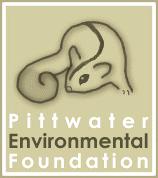Inbox and Environment News: Issue 277
August 21 - 27, 2016: Issue 277
NSW Call to community and government groups to apply for local environmental grants
Media release: 15 August 2016 – NSW Office of Environment and Heritage (OEH)
A total of $4 million in grant funds is available to community groups and government entities for a range of local environment restoration and improvement projects under the NSW Environmental Trust’s 2016/17 Restoration and Rehabilitation Grant Program.
Terry Bailey, Chief Executive, NSW Office of Environment and Heritage and Trust Secretary said the grants will deliver grassroots funding to local environmental projects that restore, protect and enhance a variety of NSW environments.
“This valuable grant program has been running for over 20 years, making it one of the longest running environmental grant programs in Australia,” Mr Bailey said.
“Grants are awarded to help protect important ecosystems, to restore degraded environments and care for habitats of rare and endangered flora and fauna.
“I encourage community groups, not-for-profit and government entities from across the state to apply for a grant and help their local communities protect and conserve our vital natural environment.
“Fifty-six grants were awarded under this program last year and their projects are now tackling a number of local environmental issues.
“Thanks to this grant program landholders, local councils, state government agencies and community groups are now working to restore habitats for native and endangered species, improve water quality and rehabilitate wetland areas.
“As an example, Greening Australia’s $96,730 project is helping improve habitat for the vulnerable Glossy Black Cockatoo. Working alongside landholders, 5,000 trees are being planted and community seed collection and bird identification workshops are taking place.”
Applications open for the 2016/17 round of the Restoration and Rehabilitation Grant Program on 15 August 2016. Grants between $5,000 and $100,000 are available. Applications close on 26 September 2016.
Visit the Environmental Trust website for applications and further information: www.environment.nsw.gov.au/grants/restoration.htm
Government funding boost for local councils tackling climate change
Media release: 16 August 2016 NSW Office of Environment and Heritage (OEH)
The NSW Office of Environment and Heritage (OEH) has announced an extension of the Government’s successful Building Resilience to Climate Change (BRCC) program, which invites local government organisations to apply for grants up to $80,000. The project builds resilience to climate change in local communities by addressing identified risks and vulnerabilities.
Announcing the third round of funding, OEH Deputy Chief Executive Ian Hunter said local councils have a role in helping to manage the risks of climate change in their communities.
“They are responsible for a broad range of services likely to face significant impacts from climate change, such as public infrastructure, development and planning, environmental management, and protecting public health and safety.
“The third round of the Building Resilience to Climate Change program has now opened, offering $460,000 in grants for projects that build resilience to climate change.
“This round we are inviting council projects that build resilience of vulnerable communities or adapt priority infrastructure to climate change,” Mr Hunter said.
LGNSW President Keith Rhoades said adapting to climate change is important for all spheres of government, with the breadth of projects under consideration demonstrating a vast range of innovative and collaborative local solutions.
“The high level of interest from local government in this issue shows councils are seeking to tackle climate change risks within their day-to-day operations, including service delivery and infrastructure, to help protect their communities,” Cr Rhoades said.
“We are delighted that the Government has decided to extend this vital stream of funding support for councils to address climate risks.”
The grants encourage collaboration through local alliances, common activities and resource sharing, which builds capacity to address risks and vulnerabilities in regional communities.
“The effects of climate change pose different risks in different areas of NSW,” Cr Rhoades said.
“Fostering adaptation action at a local level helps all of NSW build resilience to climate change by creating networks between community organisations, local councils and businesses and the NSW Government.”
The Government’s climate information portalwww.climatechange.environment.nsw.gov.au provides local scale climate projections and impacts information, which enables local decision makers to build resilience to extreme events and plan for the future.
Mr Hunter said when state and local government work together to manage the risks of climate change in communities, it can reduce long-term economic, social and environmental costs.
“The first two BRCC rounds received proposals for 120 climate change adaptation projects, seeking over $5 million in state government support. So far 14 projects have been funded to the tune of $890,330.
“To date 60 councils, seven NSW agencies, four research institutions, three community groups, and four businesses are working together to deliver adaptation projects across the state.
“This program has been extremely well received by local government, with high participation rates and strong program outcomes. It’s the most recognised adaptation resource in the State*,” Mr Hunter said.
The BRCC is administered and supported by Local Government NSW. Application forms are available at: www.lgnsw.org.au/policy/climate-change/building-resilience .
*as assessed in the 2015 Climate Change Adaptation Survey of NSW local government needs.
NSW Call to community and government groups to apply for local environmental grants
Media release: 15 August 2016 – NSW Office of Environment and Heritage (OEH)
A total of $4 million in grant funds is available to community groups and government entities for a range of local environment restoration and improvement projects under the NSW Environmental Trust’s 2016/17 Restoration and Rehabilitation Grant Program.
Terry Bailey, Chief Executive, NSW Office of Environment and Heritage and Trust Secretary said the grants will deliver grassroots funding to local environmental projects that restore, protect and enhance a variety of NSW environments.
“This valuable grant program has been running for over 20 years, making it one of the longest running environmental grant programs in Australia,” Mr Bailey said.
“Grants are awarded to help protect important ecosystems, to restore degraded environments and care for habitats of rare and endangered flora and fauna.
“I encourage community groups, not-for-profit and government entities from across the state to apply for a grant and help their local communities protect and conserve our vital natural environment.
“Fifty-six grants were awarded under this program last year and their projects are now tackling a number of local environmental issues.
“Thanks to this grant program landholders, local councils, state government agencies and community groups are now working to restore habitats for native and endangered species, improve water quality and rehabilitate wetland areas.
“As an example, Greening Australia’s $96,730 project is helping improve habitat for the vulnerable Glossy Black Cockatoo. Working alongside landholders, 5,000 trees are being planted and community seed collection and bird identification workshops are taking place.”
Applications open for the 2016/17 round of the Restoration and Rehabilitation Grant Program on 15 August 2016. Grants between $5,000 and $100,000 are available. Applications close on 26 September 2016.
Visit the Environmental Trust website for applications and further information: www.environment.nsw.gov.au/grants/restoration.htm
Government funding boost for local councils tackling climate change
Media release: 16 August 2016 NSW Office of Environment and Heritage (OEH)
The NSW Office of Environment and Heritage (OEH) has announced an extension of the Government’s successful Building Resilience to Climate Change (BRCC) program, which invites local government organisations to apply for grants up to $80,000. The project builds resilience to climate change in local communities by addressing identified risks and vulnerabilities.
Announcing the third round of funding, OEH Deputy Chief Executive Ian Hunter said local councils have a role in helping to manage the risks of climate change in their communities.
“They are responsible for a broad range of services likely to face significant impacts from climate change, such as public infrastructure, development and planning, environmental management, and protecting public health and safety.
“The third round of the Building Resilience to Climate Change program has now opened, offering $460,000 in grants for projects that build resilience to climate change.
“This round we are inviting council projects that build resilience of vulnerable communities or adapt priority infrastructure to climate change,” Mr Hunter said.
LGNSW President Keith Rhoades said adapting to climate change is important for all spheres of government, with the breadth of projects under consideration demonstrating a vast range of innovative and collaborative local solutions.
“The high level of interest from local government in this issue shows councils are seeking to tackle climate change risks within their day-to-day operations, including service delivery and infrastructure, to help protect their communities,” Cr Rhoades said.
“We are delighted that the Government has decided to extend this vital stream of funding support for councils to address climate risks.”
The grants encourage collaboration through local alliances, common activities and resource sharing, which builds capacity to address risks and vulnerabilities in regional communities.
“The effects of climate change pose different risks in different areas of NSW,” Cr Rhoades said.
“Fostering adaptation action at a local level helps all of NSW build resilience to climate change by creating networks between community organisations, local councils and businesses and the NSW Government.”
The Government’s climate information portalwww.climatechange.environment.nsw.gov.au provides local scale climate projections and impacts information, which enables local decision makers to build resilience to extreme events and plan for the future.
Mr Hunter said when state and local government work together to manage the risks of climate change in communities, it can reduce long-term economic, social and environmental costs.
“The first two BRCC rounds received proposals for 120 climate change adaptation projects, seeking over $5 million in state government support. So far 14 projects have been funded to the tune of $890,330.
“To date 60 councils, seven NSW agencies, four research institutions, three community groups, and four businesses are working together to deliver adaptation projects across the state.
“This program has been extremely well received by local government, with high participation rates and strong program outcomes. It’s the most recognised adaptation resource in the State*,” Mr Hunter said.
The BRCC is administered and supported by Local Government NSW. Application forms are available at: www.lgnsw.org.au/policy/climate-change/building-resilience .
*as assessed in the 2015 Climate Change Adaptation Survey of NSW local government needs.
Bush Regeneration And Envirofun Weekend
On: August 26-28, 2016At: Pittwater YHA, Morning Bay
Volunteer for two mornings’ bush regeneration and receive free accommodation, two evening meals, two BBQ lunches and two morning teas and free use of kayaks over the weekend of 26 to 28 August. Alternatively come for a Saturday or Sunday morning bush regeneration and enjoy a morning tea and BBQ lunch and kayak. It is only a $20 contribution ($50 nonrefundable booking fee with a $30 refund on arrival) for a weekend of great company, food and activities.
Bookings essential: 9999 5748 Email: Pittwater@yha.com.au
A Pittwater YHA activity in partnership with: • Pittwater Natural Heritage Association • National Parks and Wildlife Service • Northern Beaches Council • supported by the Greater Sydney Local Land Service • with funding from the Australian Government and the NSW Government.
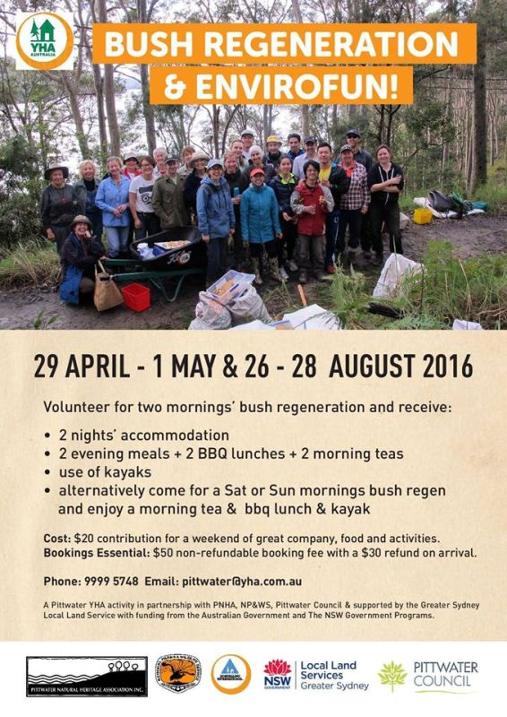

Community Landcare Grants
Greater Sydney Local Land Services 2016 Community Landcare Grants are now open!
Grants of $5,000 - $30,000 over 18 months are available for community groups, including Landcare and other 'care' groups and landholders in the Greater Sydney region.
Applications open today Monday 8th August 2016 and close Monday 12th September 2016.
Projects must align with at least 1 of the Strategic Objectives developed for the Australian Government's National Landcare Programme:
• Projects that aim to maintain and improve ecosystem services through sustainable management of local and regional landscapes.Activities funded may include weed and pest control, bush regeneration, erosion management, fencing, plant propagation and revegetation, actions that protect for threatened species, development of management plans, community participation and engagement activities and training that contribute to the protection and restoration of ecosystem function, resilience and biodiversity.
• Projects that aim to build community awareness, participation, skills and knowledge in caring for their environment, including Aboriginal knowledge and participation. Activities funded may include the delivery of workshops, training courses, awareness raising events, booklets, signage, media and other activities designed to build awareness, improve skills and knowledge and/or promote the conservation and enhancement of biodiversity.
For full details including the grant guidelines please visit the Greater Sydney Local Land Services Website
To discuss project ideas or to find out more please feel free to contact Council's Bushcare Officer on 9970 1367.Bushcare in Pittwater
For further information or to confirm the meeting details for below groups, please contact Council's Bushcare Officer on 9970 1367Council's Cooee Newsletter - May- June 2016 HERE
BUSHCARE SCHEDULES
Where we work Which day What time
Avalon
Angophora Reserve 3rd Sunday 8:30 - 11:30am
Avalon Dunes 1st Sunday 8:30 - 11:30am
Avalon Golf Course 2nd Wednesday 3 - 5:30pm
Careel Creek 4th Saturday 8:30 - 11:30am
Toongari Reserve 3rd Saturday 9 - 12noon (8 - 11am in summer)
Bangalley Headland 2nd Sunday 9 to 12noon
Bayview
Winnererremy Bay 4th Sunday 9 to 12noon
Bilgola
North Bilgola Beach 3rd Monday 9 - 12noon
Algona Reserve 1st Saturday 9 - 12noon
Plateau Park 1st Friday 8:30 - 11:30am
Church Point
Browns Bay Reserve 1st Tuesday 9 - 12noon
McCarrs Creek Reserve Contact Bushcare Officer To be confirmed
Clareville
Old Wharf Reserve 3rd Saturday 8 - 11am
Elanora
Kundibah Reserve 4th Sunday 8:30 - 11:30am
Mona Vale
Mona Vale Beach Basin 1st Saturday 8 - 11am
Mona Vale Dunes 2nd Saturday+3rd Thursday 8:30 - 11:30am
Newport
Bungan Beach 4th Sunday 9 - 12noon
Crescent Reserve 3rd Sunday 9 - 12noon
North Newport Beach 4th Saturday 8:30 - 11:30am
Porter Reserve 2nd Saturday 8 - 11am
North Narrabeen
Irrawong Reserve 3rd Saturday 2 - 5pm
Palm Beach
North Palm Beach Dunes 3rd Saturday 9 - 12noon
Scotland Island
Catherine Park 2nd Sunday 10 - 12:30pm
Elizabeth Park 1st Saturday 9 - 12noon
Pathilda Reserve 3rd Saturday 9 - 12noon
Warriewood
Warriewood Wetlands 1st Sunday 8:30 - 11:30am
Whale Beach
Norma Park 1st Friday 9 - 12noon
Western Foreshores
Coopers Point, Elvina Bay 2nd Sunday 10 - 1pm
Rocky Point, Elvina Bay 1st Monday 9 - 12noon
Bushcare in Pittwater
Where we work Which day What time
Avalon
Angophora Reserve 3rd Sunday 8:30 - 11:30am
Avalon Dunes 1st Sunday 8:30 - 11:30am
Avalon Golf Course 2nd Wednesday 3 - 5:30pm
Careel Creek 4th Saturday 8:30 - 11:30am
Toongari Reserve 3rd Saturday 9 - 12noon (8 - 11am in summer)
Bangalley Headland 2nd Sunday 9 to 12noon
Bayview
Winnererremy Bay 4th Sunday 9 to 12noon
Bilgola
North Bilgola Beach 3rd Monday 9 - 12noon
Algona Reserve 1st Saturday 9 - 12noon
Plateau Park 1st Friday 8:30 - 11:30am
Church Point
Browns Bay Reserve 1st Tuesday 9 - 12noon
McCarrs Creek Reserve Contact Bushcare Officer To be confirmed
Clareville
Old Wharf Reserve 3rd Saturday 8 - 11am
Elanora
Kundibah Reserve 4th Sunday 8:30 - 11:30am
Mona Vale
Mona Vale Beach Basin 1st Saturday 8 - 11am
Mona Vale Dunes 2nd Saturday+3rd Thursday 8:30 - 11:30am
Newport
Bungan Beach 4th Sunday 9 - 12noon
Crescent Reserve 3rd Sunday 9 - 12noon
North Newport Beach 4th Saturday 8:30 - 11:30am
Porter Reserve 2nd Saturday 8 - 11am
North Narrabeen
Irrawong Reserve 3rd Saturday 2 - 5pm
Palm Beach
North Palm Beach Dunes 3rd Saturday 9 - 12noon
Scotland Island
Catherine Park 2nd Sunday 10 - 12:30pm
Elizabeth Park 1st Saturday 9 - 12noon
Pathilda Reserve 3rd Saturday 9 - 12noon
Warriewood
Warriewood Wetlands 1st Sunday 8:30 - 11:30am
Whale Beach
Norma Park 1st Friday 9 - 12noon
Western Foreshores
Coopers Point, Elvina Bay 2nd Sunday 10 - 1pm
Rocky Point, Elvina Bay 1st Monday 9 - 12noon
Long Reef Guided Walks
Below is the Fishcare Volunteers’ upcoming Walks and Talks which might be of interest to readers. We have been offering this free service now for about 15 years. Most days see somewhere round 30 people, young and old, and we even get people from places like Auburn and further afield. I add my bit as a former Australian Museum person and we also have a geologist to talk about the landward side of Long Reef. We’re dictated by tides, hence the irregular times, but always on a Sunday.Phil Colman
Free guided walks with Fishcare Volunteers Sunday 18 Sept 2016 2 pm – 4 pm Sunday 16 Oct 2016 2 pm – 4 pm Sunday 13 Nov 2016 1 pm – 3 pm Sunday 11 Dec 2016 12 noon – 2 pm Sunday 29 Jan 2017 3.30 pm – 5.30 pm Sunday 26 Feb 2017 2.30 pm – 4.30 pm Sunday 26 Mar 2017 1.30 pm – 3.30 pm Sunday 9 Apr 2017 12.30 pm – 2.30 pm • Subject to weather conditions • Bookings and enquiries by email: longreefwalks@gmail.com
Long Reef Fishcare Educational Walks Long Reef Aquatic Reserve, on Sydney’s northern beaches is a unique environment due to its geology and exposure to all four points of the compass. Protecting a huge variety of marine animals, birds and plants, it’s a great place to enjoy learning about our natural environment.
Department of Primary Industries NSW Fishcare Volunteers offer free, guided, educational walks onto the rock platform where in just two hours you’ll observe some of the vast variety of marine life.
You’ll also gain an understanding of the geographical features of the area, look at trace fossils and learn why some migratory birds travel tens of thousands of kilometres from Siberia and Japan to spend time at Long Reef.
An ideal family outing! More information: www.reefcarelongreef.org.au
Burning Desire Comes Down To Beetles
August 17, 2016: Griffith UniversityNew Griffith University research could influence how often prescribed burning is conducted after it was found high frequency fires (i.e. every 2 years) could disrupt nutrient cycling and modify beetle populations in some forest ecosystems.
"It's about conserving and understanding the whole system and finding the right burning frequency, not just for the bigger trees, but the insects and microbes as well. Too frequent as well as too infrequent fire can be problematic and this research may help to better inform fire frequency management," says PhD researcher Orpheus Butler.
Mr Butler, a member of Professor Chengrong Chen's Environmental Biogeochemistry Research Lab, has been studying how fire affects the balance and cycling of elements like carbon, nitrogen and phosphorus in forest ecosystems and how these effects are linked to the changes in the structure and function of plant, animal and microbial communities brought about by burning.
The South East Queensland Fire and Biodiversity Consortium has awarded Mr Butler a Research Student Scholarship to undertake ground breaking fire research, which will be presented at its Bushfire 2016 national conference, on 28-29 September at the University of Queensland.
Bushfire 2016 will be an engaging, informative and inspiring conference squarely aimed at connecting Australia's best fire scientists, ecologists and students with on ground fire operators, public land managers and private land owners.
Part of Mr Butler's PhD work looks at how the nitrogen and phosphorus in soil and plant litter is modified by frequent fire.
"We think the altered nutrient balance in soil will be reflected in the plant material and this may be linked to altered rates of plant growth. It affects different plants in different ways because some plants need relatively more nitrogen, and some need more phosphorus" he says.
"Both elements are essential for plant growth."
A study in Peachester Forest, near Woodford, found that the nitrogen and phosphorus concentrations in leaf litter and microbes were very different in the most frequently burned part of the forest.
The effects may have important consequences for the invertebrate fauna on the forest floor, given that many of these animals depend on organic material in soil and litter as a source of food.
Mr Butler says soil and litter invertebrates represent an enormous proportion of forest biodiversity and contribute to litter decomposition, which influences fuel loads future fire risk, intensity and spread.
Some invertebrates, particularly beetles, are used as indicators of ecosystem health or resilience to disturbance.
"These are all parts of a bigger system. People tend to focus on things they can see but that's not all that's going on."
The study will enhance knowledge of fundamental ecological processes, improve the ability to use invertebrates as indicators of appropriate prescribed burning frequencies, and thereby assist in the management of forested landscapes, assessment of fire risk and species conservation.
Bushfire 2016 offers two days of concurrent sessions featuring internationally recognised keynote speakers, including Professor Ross Bradstock from the University of Wollongong and Associate Professor Alan York from Melbourne University. The program covers ten different themes, including fire risk, fire ecology, climate change, Indigenous fire practices, land management and community partnerships and is complimented by a catered poster session on the Wednesday evening, an informal dinner on the Thursday night and two field trips on the Friday.
Dr Samantha Lloyd, Manager of the Consortium, says, "We are thrilled with the support we are receiving for Bushfire 2016. The program features over 75 talks and has something for everyone. Whether you are a researcher or practitioner, our aim is to provide a broad range of fantastic presentations that help bridge the gap between research and on ground fire practice."
For more information visit www.fireandbiodiversity.org.au/bushfire-2016
Have Your Say On The Amended Rocky Hill Coal Project Application
17.08.2016 : Departmental Media Release - Department of Planning and EnvironmentAn amended development application by Gloucester Resources Limited for the Rocky Hill Coal Project will be on exhibition from today for community consultation.
The Department of Planning and Environment is keen to hear the community’s views on the amended proposal which involves:- developing and operating an open-cut coal mine to produce up to two million tonnes of coal per year for up to 21 years
- constructing and operating a private coal haul road linking the Rocky Hill Coal Project with the Stratford Coal Complex, approximately nine kilometres to the south
- using the private haul road to transfer coal between 7:00 am and 6:00 pm only, Monday to Saturday
- using the private coal haul road to deliver heavy equipment and construction materials to the mine area
- rehabilitating the site
A spokesperson for the Department said the public should also view the modification application for the Stratford Extension Project, which is being exhibited simultaneously with the amended Rocky Hill Coal Project proposal.
“The public should also note the changes from a previous Rocky Hill Coal Project proposal which was exhibited in 2013,” a spokesperson said.
“Key changes in the amended proposal include three open cut pits instead of four and no night-time hours of work. Additionally, it proposes no evening hours of work for the first three years of the project.
“In the new proposal, coal would be hauled on a private haul road to the nearby Stratford Coal Mine. The Rocky Hill project would therefore not need a Coal Handling and Preparation Plant or a rail loop and train loading bin, or a coal conveyor. The amended proposal does not include:- constructing and operating an on-site Coal Handling and Preparation Plant
- constructing and operating a Rail Load-out Facility, including a rail loop and overhead loading bin, to dispatch the product coal to the Port of Newcastle
- developing a three kilometre partially-enclosed overland conveyor, to link the CHPP to the Rail Load-out Facility
- operating the mine during night-time hours
- operating the mine during evening hours for the first three years of the mining operations.
A spokesperson for the Department said the local community always has an opportunity to share their views.
“Community consultation is an integral part of the planning process and the applicant will have to respond to the feedback we receive.
“This feedback is taken into consideration as part of the assessment. “It’s easy to participate by going online and we encourage everyone to take a look and have their say.”
To make a submission or view the Environmental Impact Statement (EIS), visit www.majorprojects.planning.nsw.gov.au
Submissions can be made from 17 August until 14 October 2016.
Written submissions can also be made to: Department of Planning and EnvironmentAttn: Director – Resource AssessmentsGPO Box 39 Sydney NSW 2001
The application and EIS are also available to view in person at: Department of Planning and Environment, 23-33 Bridge Street, SydneyNature Conservation Council, Level 14, 338 Pitt Street, Sydney Mid Coast Council Offices:- 89 King Street, Gloucester - Breese Parade, Forster- 2 Pulteney Street, Taree- Customer Service Centre, 6 Church Lane, Stroud (9 am to noon)
Have your say on the modification application for Stratford Extension Project17.08.2016 : Departmental Media Release Author: Department of Planning and Environment
A modification application for the Stratford Extension Project will be on exhibition from today for community consultation.
The Department of Planning and Environment is keen to hear the community’s views on Stratford Coal Pty Ltd’s modification application which seeks to:- use a private haul road to transfer coal from the Rocky Hill Coal Project to the Stratford Coal Mine site
- construct an extension of the existing coal stockpile to accommodate Rocky Hill’s coal, and process coal from this stockpile through the existing Stratford Coal Handling and Preparation Plant
- place Rocky Hill product coal on the existing Stratford product coal stockpile
- load and dispatch Rocky Hill product coal from Stratford’s existing rail loop and coal load-out system
The community can also view the related but separate Rocky Hill Coal Mine amended development application also on exhibition currently, and make a submission.
A spokesperson for the Department of Planning and Environment said the local community always has an opportunity to share their views.
"Community consultation is an integral part of the planning process and the applicant will have to respond to the feedback we receive," the spokesperson said.
"This feedback is taken into consideration as part of the assessment. "It’s easy to participate by going online and we encourage everyone to take a look and have their say."
To make a submission and the view the modification application visit www.majorprojects.planning.nsw.gov.au
Submissions can be made from 17 August to 14 October 2016. Written submissions can also be made to:Department of Planning and EnvironmentAttn: Director – Resource AssessmentsGPO Box 39 Sydney NSW 2001 The application is also available to view in person at:Department of Planning and Environment, 23-33 Bridge Street, SydneyNature Conservation Council, Level 14, 338 Pitt Street, Sydney Mid Coast Council Offices:- 89 King Street, Gloucester - Breese Parade, Forster- 2 Pulteney Street, Taree- Customer Service Centre, 6 Church Lane, Stroud (9 am to noon)
- developing and operating an open-cut coal mine to produce up to two million tonnes of coal per year for up to 21 years
- constructing and operating a private coal haul road linking the Rocky Hill Coal Project with the Stratford Coal Complex, approximately nine kilometres to the south
- using the private haul road to transfer coal between 7:00 am and 6:00 pm only, Monday to Saturday
- using the private coal haul road to deliver heavy equipment and construction materials to the mine area
- rehabilitating the site
- constructing and operating an on-site Coal Handling and Preparation Plant
- constructing and operating a Rail Load-out Facility, including a rail loop and overhead loading bin, to dispatch the product coal to the Port of Newcastle
- developing a three kilometre partially-enclosed overland conveyor, to link the CHPP to the Rail Load-out Facility
- operating the mine during night-time hours
- operating the mine during evening hours for the first three years of the mining operations.
- use a private haul road to transfer coal from the Rocky Hill Coal Project to the Stratford Coal Mine site
- construct an extension of the existing coal stockpile to accommodate Rocky Hill’s coal, and process coal from this stockpile through the existing Stratford Coal Handling and Preparation Plant
- place Rocky Hill product coal on the existing Stratford product coal stockpile
- load and dispatch Rocky Hill product coal from Stratford’s existing rail loop and coal load-out system
United Wambo Open Cut Coal Mine Project
Street 134 Jerrys Plains RoadCity WarkworthExhibition Start 11/08/2016Exhibition End 22/09/2016
See all available documents and have your say here
A Joint Venture project between United Collieries and Wambo Coal which combines the existing open cut operations at Wambo with a proposed new open cut at United.
The Project will utilise the existing Wambo Mining Infrastructure Area (MIA), Coal Handling and Preparation Plant (CHPP) and train loading facility. The Project anticipates delivering up to 6Mtpa of product coal, providing jobs for around 500 employees with a life of mine of approximately 23 years. The Project proposes to relocate a 2km section of the Golden Highway and a section of 330kV powerlines to optimise coal recovery in the United Open Cut.
Extent of Mining Areas: Refer to Figure 1.3 - The project proposes realignment of the Wambo Open Cut boundary to maximise resource recovery. The realignment would result in approximately 5 hectares of additional disturbance for the Wambo Open Cut mine.
The Proposed United Open Cut mine is situated to the weast of the existing Wambo operations (refer to Figure 1.3)
The conceptual staged mine plans are shown on Figure 3.2 to Figure 3.6
Operating Hours 24 hours a day, 7 days a week
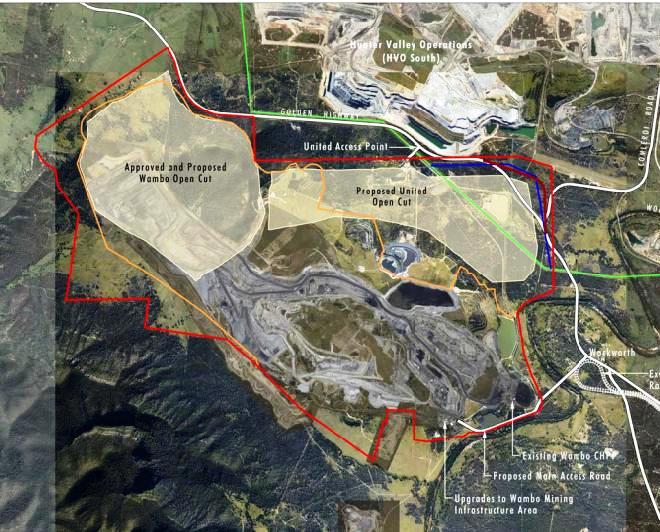
Figure 1.3
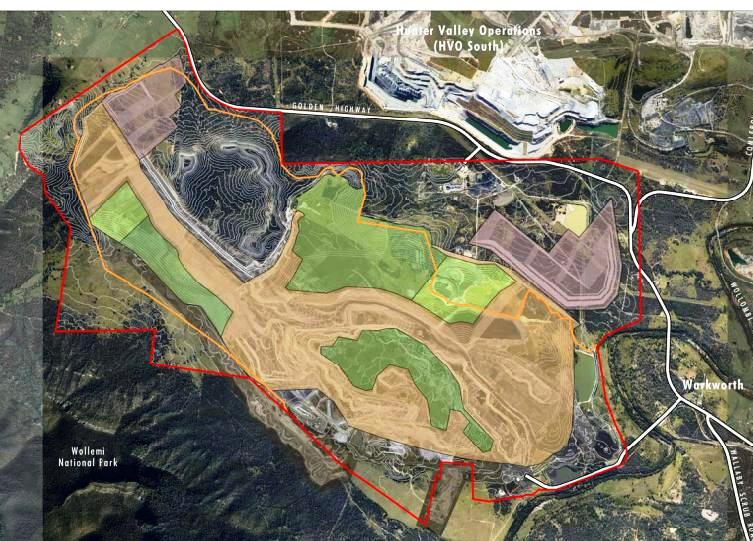
Figure 3.2


Have Your Say On Wyong Coal Mine
Wallarah 2 Coal ProjectEstablishment of an underground coal mine and associated infrastructure (see Preliminary Environmental Assessment). The proposal will also require Commonwealth assessment under the EPBC Act.
Exhibition Start 22/07/2016Exhibition End 05/09/2016
City WyongState NSWPost Code 2259Country AustraliaLocal Governments Lake Macquarie City Council and Wyong Shire Council
All Documents at: majorprojects.planning.nsw.gov.au/index.pl?action=view_job&job_id=4974 Amended application Document: HERE
The key features of the Project include:
• A deep underground longwall mine extracting up to 5 Million tonnes per annum of export quality thermal coal; • The Tooheys Road Site (located north-east of the intersection of the M1 Motorway and the Motorway Link Road) which includes a portal, coal handling facilities and stockpiles, water and gas management facilities, small office buildings, workshop, coal transportation infrastructure and connections to municipal water and sewerage systems; • The Buttonderry Site (near the intersection of Hue Hue Road and Sparks Road) which includes administration offices, bathhouse, personnel access to the mine, ventilation shafts and water management structures; • The Western Ventilation Shaft Site (located in the Wyong State Forest) includes a downcast ventilation shaft and water management structures; • An inclined tunnel (or ‘drift’) from the surface at the Tooheys Road Site to the coal seam beneath the Buttonderry Site; • Transportation of product coal to the Port of Newcastle by rail; and •An operational workforce of 300 full time employees.
The Project constitutes State Significant Development. As such, the Project has been subject to the assessment process under Division 4.1 of Part 4 of the Environmental Planning & Assessment Act 1979.Have your Say on Springvale Coal Mine
Modification to Springvale Extension ProjectExhibition Start 02/08/2016Exhibition End 23/08/2016
Proposed modification to Springvale Mine's consent SSD 5594 to (i) increase run of mine coal production limit from the approved 4.5 Mtpa to 5.5 Mtpa, (ii) increase workforce from the approved 310 full time equivalent personnel to 450 full time equivalent personnel, (iii) increase coal stockpile capacity at the Springvale pit top from the approved 85,000 tonnes to 200,000 tonnes. Amend applicant name on SSD 5594 from 'Centennial Springvale Pty Limited' to 'Springvale Coal Pty Limited'.
Visit:
Katandra Sanctuary
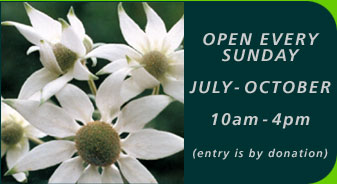
Katandra is a sanctuary for flora and fauna where the wildflowers are their most colourful during spring but all year round there are opportunities for bird watching. The sanctuary covers 12 hectares and is situated on the Ingleside/Warriewood escarpment. Choose to follow a short walk of about 1km or the longer 2km track through rainforest remnants with creeks and fern-fringed pools. Visit: www.katandra.orgMuogamarra in bloom
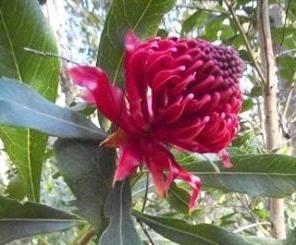 With spring just around the corner, it’s a great time of year to get outdoors in a national park and enjoy the crisp sunny days and beautiful blossoming flowers.
With spring just around the corner, it’s a great time of year to get outdoors in a national park and enjoy the crisp sunny days and beautiful blossoming flowers.
Muogamarra Nature Reserve, located in the northern outskirts of Sydney, transforms into a brilliant display of colour each August and September, when spring wildflowers come into bloom.
The reserve is only open for six weekends a year to preserve the fragile ecosystems and Aboriginal heritage, and this year, will be open each Saturday and Sunday from 13 August to 18 September.
The best way to explore the extraordinary nature reserve is on a special guided tour. There are three guided walks on offer, where you’ll see and learn about the reserve’s spectacular plants and enjoy stunning scenery.Or for the more adventurous, join the full-day 18km kayaking tour along the Hawkesbury River to see the reserve from the shoreline, take in the sheer cliffs and learn about the area’s fascinating history.
Challenge yourself on The Coast trackLooking for a walking adventure close to Sydney? The Coast track in Royal National Park, just one hour south of the CBD, is definitely one for your to-do-list.
You’ll walk along cliffs, beaches and escarpments, taking in magnificent ocean views and the rugged beauty of the coastline as you go.The 26km track can be walked over two days, combined with an overnight camping experience, or broken up into a series of day walks.
There’s also been no better time to lace up the boots and set out, as the track has recently undergone a $1.8 million upgrade over nine months. Works included construction of sandstone stairways and installation of 2.2km of new boardwalk at several sites.
This work has enhanced the walking experience for visitors, but has also prevented soil erosion and protected coastal vegetation.
The Coast track will also benefit from the recent funding announcement from the NSW Government, with $3.6 million allocated for the next 12 months and $9 million over four years.

 With spring just around the corner, it’s a great time of year to get outdoors in a national park and enjoy the crisp sunny days and beautiful blossoming flowers.
With spring just around the corner, it’s a great time of year to get outdoors in a national park and enjoy the crisp sunny days and beautiful blossoming flowers.First Case Of Russian Wheat Aphid Confirmed In NSW
16 Aug 2016: NSW Department of Primary IndustriesNSW Department of Primary Industries has confirmed the first detection of Russian wheat aphids (Diuraphis noxia) in a wheat crop in the State's south.
Scientists at NSW DPI Biosecurity Collections unit have confirmed the sample from the Barham area in the Murray Region contained Russian wheat aphid.
NSW DPI Director Plant Biosecurity Satendra Kumar said a national management approach for Russian wheat aphid was developed following the first detections in South Australia in May and Victoria in June.“Russian wheat aphid has been deemed as non-eradicable by the National Biosecurity Management Group. Grain growers should be on the lookout for the pest and consider their management options,” said Dr Kumar.
“Grain growers are encouraged to contact their agronomist or seek advice from NSW DPI, Local Land Services or refer to the GRDC website for information on how to manage the pest in cereal crops.“There are tools available to help manage the aphid, including an emergency use permit (PDF, 114.6 KB) for specific chemicals that has been issued by the Australian Pesticide and Veterinary Medicines Authority.
“Grain growers planning to spray are encouraged to adhere to all general chemical use practices.”
“The advice to growers and agronomists is to continue to monitor your crops for aphids and symptoms and if you suspect the presence of the Russian wheat aphid, take a sample for identification.
“To limit the spread of the pests and diseases hygiene is important. It is important to put best practice biosecurity measures into place to reduce the risk of transporton clothing, footwear, vehicles and machinery when moving between paddocks and farm,” said Dr Kumar
Poppy Production Potential For NSW
Friday August 12, 2016Minister for Primary Industries, Niall Blair, has introduced the Poppy Industry Bill 2016 into the NSW Parliament, to enable Australian alkaloid poppy production to extend into NSW.
Mr Blair said Tasmania already produces about half of the world’s alkaloid poppies, which pharmaceutical companies use to produce medical grade compounds for various medicines.
“With growing demand for poppies, there is no good reason why the NSWGovernment should have impediments in place stopping our primary producers from participating in this industry,” said Mr Blair.
“We’ve got the right growing conditions, the biggest, best and most innovative farming sector in the country – all we needed was the legislative changes to allow poppies to be grown in NSW, and that’s what this Bill will achieve.”
The Poppy Industry Bill 2016 will ensure that there is a stringent regulatory regime in place and that fit and proper process, controls and balances are enforced.
Alkaloid poppy production will be highly regulated at state, national and international levels, with strict controls providing appropriate safeguards against the unauthorised cultivation and misuse of poppies.
Alkaloid poppies will only be grown by licensed growers with a contract to a licensed processor, and all products will be stringently tracked as it moves through the supply chain.
The introduction of the poppy industry into NSW will help strengthen Australia's position as a reliable supplier of high quality raw materials for the global pharmaceutical industry.
With the removal of the legislative barrier to growing alkaloid poppies in NSW, the NSW Department of Primary Industries will work with processors and farmers to help kick start this new industry.
New Chickpea Variety For Superior Disease Resistance
Wednesday, 17 August 2016Minister for Primary Industries, Niall Blair and Grains Research and Development Corporation (GRDC) Northern Panel Chair James Clark today announced the release of a new chickpea variety with superior disease resistance at the AgQuip Field Days in Gunnedah.
Mr Blair said the NSW Government, through the Department of Primary Industries (DPI) is partnering with GRDC to invest in priority research needs, key researchers and research facilities to help improve productivity and profitability of farm businesses.
“The national chickpea crop this year is estimated to have a farm gate value of over $700 million and is the backbone of the norther cropping region with 70 per cent grown in this area,” Mr Blair said.
“We are proud to announce the newest desi chickpea variety PBA Seamer during this the International Year of Pulses.
“This new chickpea variety will give our local farmers an edge over their global counterparts and help them to capture a greater market share in lucrative local and global markets.”
GRDC Northern Panel Chair, James Clark said PBA Seamer has the highest available Ascochyta blight resistance rating compared to PBA HatTrick and PBA Boundary, and is also moderately resistant to Phytophthora root rot.
“Under very high Ascochyta blight disease pressure, PBA Seamer outperforms with minimal yield loss, compared with 76 per cent yield loss in the current industry benchmark variety,” said Mr Clark.
“This means, through reduced fungicide use the cost of production will drop by $21 million per annum compared to the current industry standard.”Interested growers can hear first-hand from local DPI researchers about the range of issues that directly affect their farming systems at the 2016 AgQuip Field Days in Gunnedah.New Antarctic ice discovery aids future climate predictions
Press release issued: 16 August 2016 - University of BristolA team of British climate scientists comparing today's environment with the warm period before the last ice age has discovered a 65 percent reduction of Antarctic sea ice around 128,000 years ago.
The finding is an important contribution towards the challenge of making robust predictions about the Earth's future climate.
Reporting today in the journal Nature Communications scientists describe how by reconstructing the Earth's climate history through analysis of Antarctic ice cores they can determine what environmental conditions were like during ice ages and past warm periods.
This study focussed on sea ice conditions during the most recent warm period – known as the last interglacial – when global temperatures were similar to today.
Sea ice in the Arctic and around Antarctica regulates climate as, in summer vast areas of whiteness reflect heat from the sun back into the atmosphere, whilst in winter, sea ice prevents heat from escaping from the warm ocean to the air.
Current climate models forecast a reduction in Antarctic sea ice of up to about 60 percent by the end of the next century. Finding a 65 percent reduction in the climate record during a time when global climate conditions were similar to the present day is especially relevant.
The research team from British Antarctic Survey (BAS) and from the Universities of Bristol, Reading, Leeds and Cambridge studied data from ice cores drilled on the East Antarctic Ice Sheet.
A climate model was then used in the analysis of these data. The ice core data and climate model simulations were combined using advanced statistical techniques to determine the state of Antarctic sea ice 128,000 years ago.
Lead author Max Holloway of British Antarctic Survey explains: "We know that the Earth's climate is changing and that climate models predict a warmer world. What we are not yet sure about is the precise magnitude of future change or the timeline.
"This is where looking into the past can help. We used a number of analytical techniques to quantify change in sea ice extent around Antarctica during this important past warm period.
"We were expecting to see a relationship between warm temperatures around 128,000 years ago and a past collapse of the West Antarctic Ice Sheet.
"Surprisingly, we found that a major retreat of Antarctic sea ice is a more likely explanation. Our analysis suggests that a collapse of the West Antarctic Ice Sheet occurred later during the last interglacial.
"Something that our team will be looking at in more detail through another collaborative UK-US project."
Co-author, Professor Paul Valdes of the School of Geographical Sciences at the University of Bristol, said: "These results change our ideas about how the Antarctic responded in the past and will help us improve our understanding of likely future changes."
Today researchers observe differences between sea ice changes at both poles. This is largely due to different geography – the Arctic being a frozen sea surrounded by land and the Antarctic being a frozen landmass surrounded by sea. Whilst a rapid sea ice retreat has been recorded in the Arctic in recent decades, sea ice extent around some parts of the Antarctic have grown. Understanding the similarities and differences between hemispheres has been the subject of intense study by the international polar research community.
Research group leader, Dr Louise Sime, of BAS, said: "The current rapid retreat of sea ice in the Arctic Sea is of critical importance to Arctic ecosystems and global climate.
"By uncovering, for the first time, a huge retreat around Antarctica we have established that sea ice in the Southern Hemisphere is also susceptible to major climate changes. This discovery will help us understand whether similar sea ice retreat events are likely in a future high-CO2 world.
"Although Arctic sea ice has diminished during the past 30 years, little change has been observed around Antarctica. This discovery in the ice core record of a massive loss of sea ice provides evidence that Antarctic sea ice can also undergo similar major reductions. This may give vital clues to what might happen by the end of the next century."
'Antarctic last interglacial isotope peak in response to sea ice retreat not ice-sheet collapse' by Max D. Holloway, Louise C. Sime, Joy S. Singarayer, Julia C. Tindall, Pete Bunch & Paul J. Valdes is published this week in Nature Communications. DOI: 10.1038/ncomms12293
New Format As Pigs Fly In For Warrumbungles Concert
Media release: 9 August 2016 by NPWSA new format for the Warrumbungles Crooked Mountain Concert will see some of Australia’s up and coming country, rock and bluegrass artists perform at the signature Coonabarabran event on Saturday 5 November.
Coonabarabran National Park Visitor Centre Manager May Fleming said the concert was one of the region’s longest running community festivals.“The Crooked Mountain Concert has always featured a range of genres from the jazz tones of James Morrison to rock acts like year’s Boom Crash Opera.
“This year we’re delighted to have a really unique act in “The Pigs” leading an entertaining line up of artists.
“If you’ve never heard The Pigs unique way of performing well known pop songs in a toe-tapping hill billy style, then you’re in for a great surprise.
“Fresh from performances at Vivid Sydney and the Gympie Muster, The Pigs will be joined by Byron Bay Bluesfest openers Ivy as well as Golden Guitar nominee Mickey Pye, the tight harmonies of Bathurst duo Smith and Jones and local favourite Annie McKinnon.
“It’s a fresh line up and will continue our tradition of delivering great music in the phenomenal setting that is the Warrumbungle National Park, just designated as Australia’s first Dark Sky Park.
“We plan it with families in mind and there will be kids activities, local produce and non-alcoholic drinks available to purchase, visitors can also bring along their own picnic rugs, chairs, food and alcohol and of course camping is also available.
“This year we have been able to lower the ticket price to just $55 per adult, $50 Concession, $20 child (15 – 5 years) and under 5s are free,” Ms Fleming said.
Tickets will be on sale through Moshtix from 1 August, from the Warrumbungles National Park Visitor Centre in person or by phoning 6825 4364
Bus tickets from Coonabarabran and camping can also be purchased from the visitor centre. For more information visit the website:www.nationalparks.nsw.gov.au/crookedmountainNew wind energy framework to give certainty
01.08.2016: Ministerial Media Release- The Hon. Rob Stokes MP, Minister for PlanningA new wind energy planning framework will ensure that NSW has the right settings to attract investment in wind energy, while balancing the interests of the community. The new framework will address delays in the assessment process that in one case required more than 2500 days for a project to be determined. The average determination times for wind projects in the past five years has been more than 1000 days. Planning Minister Rob Stokes said the new framework is focused on driving better outcomes by encouraging proponents to engage early with the community. The policy framework has been developed in response to issues raised by community and industry around uncertainty in the application of the draft 2011 wind farm guidelines. Mr Stokes is inviting the community to have its say on the new planning framework. “We’ve consulted widely, including with key environmental groups, industry, other states and the Australian National Wind Farms Commissioner, to better understand the key issues in developing this framework,” Mr Stokes said. Overwhelmingly, the most contentious issues in dealing with wind projects are noise and visual impacts. The framework will provide guidance to the industry on how to better design their projects with these impacts in mind, in the context of environmental, social and economic impacts. It will provide greater certainty and consistency for the renewable energy industry and the community. Importantly, there will be no arbitrary buffer zones based on the height of turbines. For all other assessment requirements, wind energy developments will be subject to the same assessment framework as other State Significant Developments. “This new framework puts in place processes to identify potential impacts at an early stage to minimise conflict and delays,” Mr Stokes said. “The framework strikes the appropriate balance between giving clear guidance to industry whilst ensuring that the impacts of the project are assessed on their merit. “NSW has valuable wind and solar resources by international standards with many of the best areas located near existing electricity transmission infrastructure. The new framework will help NSW capture benefits from this industry and encourage investment in the State.” “We look forward to further engagement with community and stakeholders through the consultation period.” Submissions for the proposed wind energy framework can be made until 16 September 2016. The proposed new framework can be viewed at the link below or at the Department of Planning and Environment, 23-33 Bridge St, Sydney. Submissions can be made:• by post to Department of Planning and Environment, Attention: Director, Industry and Infrastructure Policy, GPO Box 39, Sydney NSW 2001• Submissions close on 16 September 2016.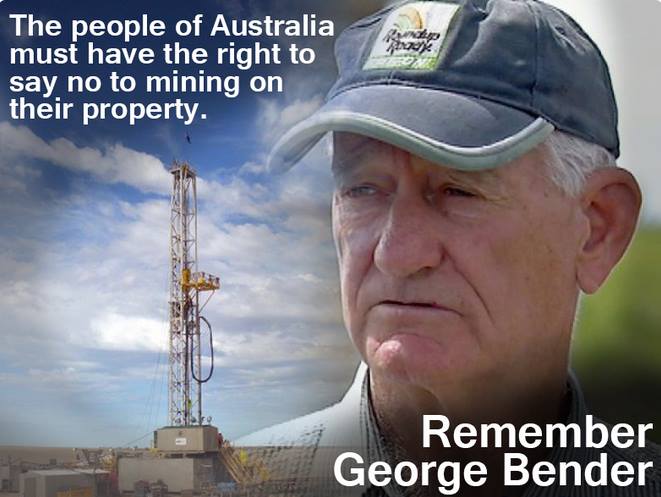
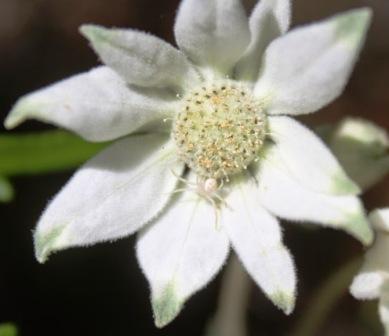

What Does PNHA do?
On-ground bush regeneration. eg: Asparagus Fern Out Days
Activities: guided walks, bird-watching
Quaterly informative newsletter, online or paper
Members email group for leaset environmental news and events
AGM with Guest Speaker
Free advice for members on managing gardens for Native Vegetation and fauna habitat
Lobbies Pittwater Council and State Government on inappropriate management practices and development
Provides support to Council for PNHA-approved grant applications for environmental projects
Publications: Introductory Field Guide to Birds of Warriewood Wetlands & Irrawong Reserve, $20.00rrp, attractive cards with photos of Pittwater scenes, flora and fauna $2.00
Email: pnhainfo@gmail.com Or click on Logo to visit website.
 Av Green Team
Av Green Team
ProfileThis Youth-run, volunteer-based environment initiative has been attracting high praise from the founders of Living Ocean as much as other local environment groups recently.
Turning up for Beach Cleans, or starting their own, underlines an ‘action speaks louder than words’ ethos is at the core of this group. Pittwater's Environmental Foundation
Pittwater Environmental Foundation was established in 2006 to conserve and enhance the natural environment of the Pittwater local government area through the application of tax deductible donations, gifts and bequests. The Directors were appointed by Pittwater Council.
About 33% (about 1600 ha excluding National Parks) of the original pre-European bushland in Pittwater remains in a reasonably natural or undisturbed condition. Of this, only about 400ha remains in public ownership. All remaining natural bushland is subject to encroachment, illegal clearing, weed invasion, feral animals, altered drainage, bushfire hazard reduction requirements and other edge effects. Within Pittwater 38 species of plants or animals are listed as endangered or threatened under the Threatened Species Act. There are two endangered populations (Koala and Squirrel Glider) and eight endangered ecological communities or types of bushland. To visit their site please click on logo above.



What Does PNHA do?
On-ground bush regeneration. eg: Asparagus Fern Out Days
Activities: guided walks, bird-watching
Quaterly informative newsletter, online or paper
Members email group for leaset environmental news and events
AGM with Guest Speaker
Free advice for members on managing gardens for Native Vegetation and fauna habitat
Lobbies Pittwater Council and State Government on inappropriate management practices and development
Provides support to Council for PNHA-approved grant applications for environmental projects
Publications: Introductory Field Guide to Birds of Warriewood Wetlands & Irrawong Reserve, $20.00rrp, attractive cards with photos of Pittwater scenes, flora and fauna $2.00
Email: pnhainfo@gmail.com Or click on Logo to visit website.
 Av Green Team
Av Green TeamPittwater's Environmental Foundation
Pittwater Environmental Foundation was established in 2006 to conserve and enhance the natural environment of the Pittwater local government area through the application of tax deductible donations, gifts and bequests. The Directors were appointed by Pittwater Council.
About 33% (about 1600 ha excluding National Parks) of the original pre-European bushland in Pittwater remains in a reasonably natural or undisturbed condition. Of this, only about 400ha remains in public ownership. All remaining natural bushland is subject to encroachment, illegal clearing, weed invasion, feral animals, altered drainage, bushfire hazard reduction requirements and other edge effects. Within Pittwater 38 species of plants or animals are listed as endangered or threatened under the Threatened Species Act. There are two endangered populations (Koala and Squirrel Glider) and eight endangered ecological communities or types of bushland. To visit their site please click on logo above.
Meningococcal Disease Warning: NSW Health
Diabetes Breakthrough Part Of $70m PBS Medicines Listings
Calling Dynamic Portrait Artists
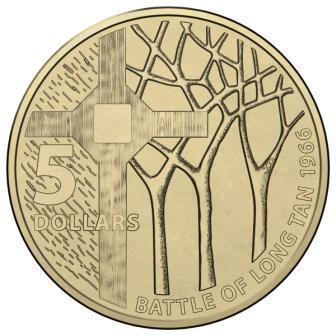
- a safer, cheaper and more efficient outdoor grain storage solution for the agricultural industry
- recycling technology for fats, oils and greases from restaurants that will save money and reduce pollution
- a lighter, stronger and more flexible concrete product
- an anti-theft automated security system for the retail fuel industry
- a cheaper, faster and safer decontamination process for mine drainage
- smaller, cheaper and more patient-friendly MRI technology used for medical diagnostics
- a 3-D printed medical device for jaw joint replacements that reduces surgery risk and improves patient quality-of-life
- insect and termite-proof expansion joint foam for the building industry, combining a two-step process into a single product.
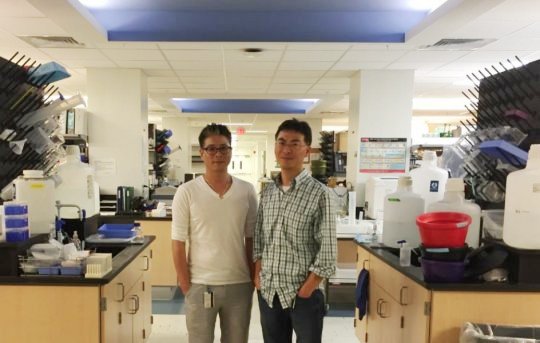
Disclaimer: These articles are not intended to provide medical advice, diagnosis or treatment. Views expressed here do not necessarily reflect those of Pittwater Online News or its staff.
